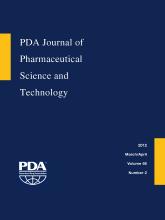Abstract
The delamination of pharmaceutical glass is a serious issue, as it can cause glass particles to appear in vials, a problem that has forced a number of drug product recalls in recent years. In Type I pharmaceutical glass vials, delamination occurs generally at the bottom and shoulder, where extensive flaming during the conversion process can favor a strong evaporation of alkali and borate species and the formation of heavily enriched silica layers. The contact with parenteral preparations dissolved in an alkaline medium increases the rate of glass corrosion, while the differential hydration of these layers can cause the detachment of flakes. The purpose of this study was to investigate the effect of the pH and the composition of the extraction solutions on the propensity of different glass types to delaminate. Repeated autoclave extractions at 121 °C were carried out on different glass types with different extraction media, including organic extractants like citric and glutaric acid. When vials were in contact with alkaline solutions and similarly aggressive media, an increase in silica extraction values indicated glass corrosion and an increasing risk for further delamination. Under such conditions expansion 33 glass is extensively corroded, showing high silica concentration and heavy flaking as compared to other glass types. Sulfur-treated glass also showed early flaking, even if SiO2 concentration was very low. A similar ranking was observed with extractions carried out with glutaric and citric acids, but at far much higher SiO2 concentration levels. Extractions with 0.9% KCl solution can be used as an accelerated test to highlight the propensity of a glass to delaminate, but in no case it can be taken as a guarantee that the glass will not delaminate when exposed to the pharmaceutical drug, whose extraction ability requires case-by-case study.
LAY ABSTRACT: How can injectable drug manufacturers prevent glass delamination? The issue of delamination is a serious one, as it can cause glass particles to appear in vials, a problem that has forced a number of drug product recalls in recent years. To combat this, pharmaceutical and biopharmaceutical manufacturers need to understand the reasons for glass delamination. The most recent cases of product recall due to the presence of particles in the filling liquid have involved borosilicate glass containers carrying drugs made of active components with known ability to corrode glass and to dissolve the silica matrix. Sometimes these ingredients are dissolved in an alkaline medium that dramatically increases the glass corrosion and potentially causes the issue. As this action is strongly affected by time and temperature, flaking may become visible only after a long incubation during storage and requires systematic monitoring to be detected at its early stage. If the nature of the filling liquid is the driving force of the phenomenon, other factors are of primary importance. The surface morphology created during vial forming is a key issue, being a function of the forming temperature that is higher in the cutting step and the forming of the bottom. Delamination occurs generally on the vial's bottom and shoulder, where extensive flaming can favor a strong evaporation of alkali and borate species and the formation of heavily enriched silica layers. When these layers are in contact with a solution, they are subject to a differential re-hydration that may result in cracking and detachment of scales. The purpose of this investigation is to identify testing conditions and parameters that can be used as indicators of an incipient delamination process. Extractions with 0.9% KCl solution for 1 h at 121 °C can be used to simulate a long-term contact with aggressive pharmaceutical preparations, while SiO2 concentration in the extract solution can be taken as an index of glass dissolution. The conclusions developed by this study can provide pharmaceutical manufacturers with information needed to help prevent glass delamination in their processes.
- Hydrolytic resistance
- Delamination
- Glass corrosion
- ICP-OES
- Accelerated extraction test
- pH
- Organic acid extractants
- © PDA, Inc. 2012
PDA members receive access to all articles published in the current year and previous volume year. Institutional subscribers received access to all content. Log in below to receive access to this article if you are either of these.
If you are neither or you are a PDA member trying to access an article outside of your membership license, then you must purchase access to this article (below). If you do not have a username or password for JPST, you will be required to create an account prior to purchasing.
Full issue PDFs are for PDA members only.
Note to pda.org users
The PDA and PDA bookstore websites (www.pda.org and www.pda.org/bookstore) are separate websites from the PDA JPST website. When you first join PDA, your initial UserID and Password are sent to HighWirePress to create your PDA JPST account. Subsequent UserrID and Password changes required at the PDA websites will not pass on to PDA JPST and vice versa. If you forget your PDA JPST UserID and/or Password, you can request help to retrieve UserID and reset Password below.






